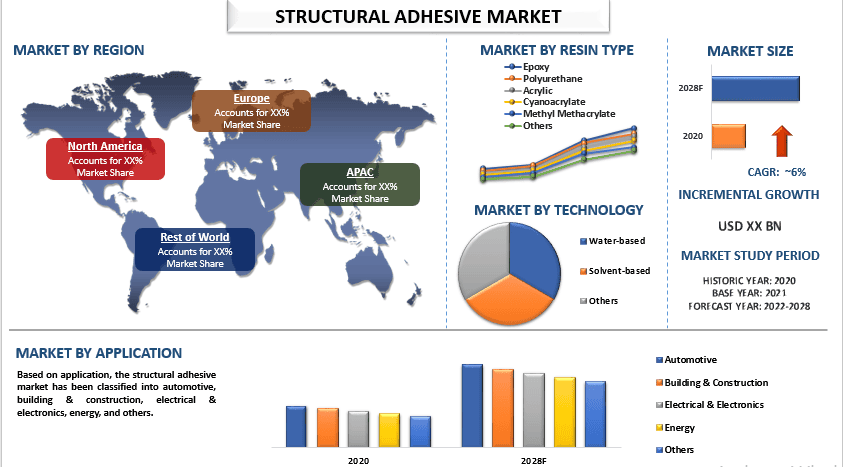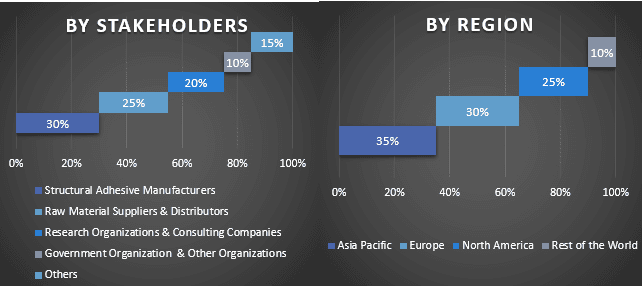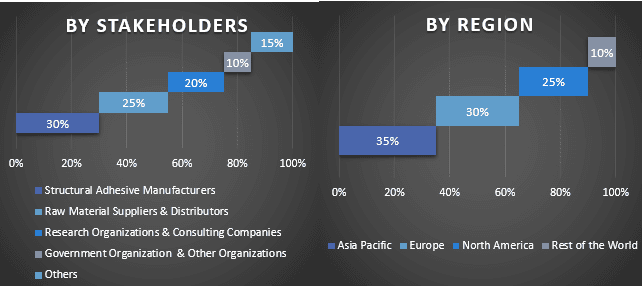Emphasis on Resin Type (Epoxy, Polyurethane, Acrylic, Cyanoacrylate, Methyl Methacrylate, and Others); Technology (Water-based, Solvent-based, and Others); Application (Automotive, Building & Construction, Electrical & Electronics, Energy, and Others); and Region/Country

Global Structural Adhesive Market is expected to grow at a significant rate of around 6% during the forecast period. A structural adhesive is a substance that solidifies on a substrate and can hold two similar or dissimilar surfaces together through face-to-face contact. These adhesives are susceptible to stress, vibration, and temperature changes, but can withstand forces and hold surfaces together securely for extended periods of time. Additionally, these adhesives are used to bond a variety of substrate materials including ceramics, metals, wood, composites, and plastics. Materials such as methacrylates, polyurethanes, cyanoacrylates, epoxies, and UV cures are also used in structural adhesive formulations. Additionally, global players are launching new trends in structural adhesives for use in various industries. For example, in March 2022, Conagen launched a bio-based removable hot melt adhesive solution to eliminate waste and reduce manufacturing costs. Major companies in the market offer structural adhesives for multiple industrial applications with technologically advanced features.
For instance, in Oct 2021, 3M announced the Next Generation Of 3M Scotch-Weld Structural Acrylic Adhesives. These include products such as 3M Scotch-Weld Low Odor Acrylic Adhesive 8700NS Series, 3M Scotch-Weld Flexible Acrylic Adhesive 8600NS Series, and 3M Scotch-Weld Nylon Bonder Structural Adhesive DP8910NS.
Henkel AG & Co. KGaA, DuPont de Nemours Inc., 3M, Sika AG, Uniseal Inc., H. B. Fuller Company, Lord Corporation, Arkema, The Dow Chemical Company, Scott Bader Co. are some of the key players in the market. Several M&As along with partnerships have been undertaken by these players to facilitate customers with hi-tech and innovative products/technologies.
Insights Presented in the Report
“Amongst resin type, epoxy resin resin type category is likely to witness the highest CAGR during the forecast period”
Based on resin type, the market is segmented into epoxy, polyurethane, acrylic, cyanoacrylate, methyl methacrylate, and others. The epoxy resin type category is likely to witness the highest CAGR during the forecast period owing to its characteristics, including resilience to high temperatures, high shear strength, high bonding strength, and improved solvent qualities, the epoxy resin type category is anticipated to see the greatest CAGR during the projection period. Additionally, they are employed in aluminum structures since they are flame resistant. Because of these characteristics, epoxy resin is in greater demand across a range of industries, including automotive, healthcare, aerospac, and others, which is propelling the market’s expansion.
“Amongst technology, the water-based adhesives to hold a significant share in the market in 2020”
On the basis of technology, the market is categorized into water-based, solvent-based, and others. Among these, water-based adhesives hold a significant share of the market in 2020. This is mainly due to the advantages of having high bonding applications in the leather, wood, and textiles industries. Additionally, they are also used because they are eco-friendly and economically viable. Furthermore, water-based structural adhesives have also been witnessing the highest adoption from the automotive sector such as assembling vehicle parts, mechanical fastening, or fixings. Thus, water-based adhesives offer better control capability and performance in various industries.
“Amongst application, the automotive category is to witness the demand during the forecast period”
Based on application, the structural adhesive market has been classified into automotive, building & construction, electrical & electronics, energy, and others. The automotive category is to witness the demand for structural adhesive during the forecast period. This is mainly because it helps in enhancing the crashworthiness of cars and other passenger vehicles as they are bonded with epoxy-based structural adhesives that help in absorbing high-impact energy at different varying temperatures. Additionally, many major players are also working on using adhesives for more use in the automotive industry. For instance, DuPont built new adhesives manufacturing facility in East China to serve customers in the transportation industry, primarily in support of two industry megatrends, vehicle electrification applications, and lightweight.
“APAC to hold a significant share in the market”
In 2020, APAC is anticipated to hold a significant share of the market during the forecast period. This is mainly due to the rising demand for heavy lifting equipment brought on by the expansion of the construction sectors in the region. Additionally, the need for structural adhesives is propelled by remodeling projects, increasing industrial and infrastructural expansions, and other factors that are increasing the market’s growth. Moreover, the constant development in technology which is leading to the designing and construction of new vehicles, or any construction sites is accelerating the growth of the market within the region. Also, major players in the market continue to invest in the development of new resin types of adhesives in the market. For instance, Bostik launched a new, innovative water-based adhesive Aquagrip 3720 for automotive interior assembly applications.
Reasons to buy this report:
Customization Options:
The Global Structural Adhesive Market can further be customized as per the requirement or any other market segment. Besides this, UMI understands that you may have your own business needs, hence feel free to connect with us to get a report that completely suits your requirements.
1. Market Introduction
2. Research Methodology Or Assumption
3. Market Synopsis
4. Executive Summary
5. Impact Of Covid-19 On The Structural Adhesive Market
6. Structural Adhesive Market Revenue, 2020-2028f
7. Market Insights By Resin Type
8. Market Insights By Technology
9. Market Insights By Application
10. Market Insights By Region
11. Structural Adhesive Market Dynamics
12. Structural Adhesive Market Opportunities
13. Structural Adhesive Market Trends
14. Demand And Supply-side Analysis
15. Value Chain Analysis
16. Competitive Scenario
17. Company Profiled
18. Disclaimer
Research Methodology for the Structural Adhesive Market Analysis (2022-2028)
Analyzing the historical market, estimating the current market, and forecasting the future market of the global structural adhesive market were the three major steps undertaken to create and analyze the adoption of structural adhesives in major regions globally. Exhaustive secondary research was conducted to collect the historical market numbers and estimate the current market size. Secondly, to validate these insights, numerous findings and assumptions were taken into consideration. Moreover, exhaustive primary interviews were also conducted, with industry experts across the value chain of the global structural adhesive market. Post assumption and validation of market numbers through primary interviews, we employed a top-down/bottom-up approach to forecasting the complete market size. Thereafter, market breakdown and data triangulation methods were adopted to estimate and analyze the market size of segments and sub-segments of the industry pertains to. Detailed methodology is explained below:
Analysis of Historical Market Size
Step 1: In-Depth Study of Secondary Sources:
Detail secondary study was conducted to obtain the historical market size of the structural adhesive market through company internal sources such as annual reports & financial statements, performance presentations, press releases, etc., and external sources including journals, news & articles, government publications, competitor publications, sector reports, third-party database, and other credible publications.
Step 2: Market Segmentation:
After obtaining the historical market size of the structural adhesive market, we conducted a detailed secondary analysis to gather historical market insights and share for different segments & sub-segments for major regions. Major segments are included in the report as resin resin type, technology, and application. Further country-level analyses were conducted to evaluate the overall adoption of testing models in that region.
Step 3: Factor Analysis:
After acquiring the historical market size of different segments and sub-segments, we conducted a detailed factor analysis to estimate the current market size of the structural adhesive market. Further, we conducted factor analysis using dependent and independent variables such as various resin type, technology, and applications of structural adhesive. A thorough analysis was conducted for demand and supply-side scenarios considering top partnerships, mergers and acquisitions, business expansion, and product launches in the structural adhesive market sector across the globe.
Current Market Size Estimate & Forecast
Current Market Sizing: Based on actionable insights from the above 3 steps, we arrived at the current market size, key players in the global structural adhesive market, and market shares of the segments. All the required percentage shares split, and market breakdowns were determined using the above-mentioned secondary approach and were verified through primary interviews.
Estimation & Forecasting: For market estimation and forecast, weights were assigned to different factors including drivers & trends, restraints, and opportunities available for the stakeholders. After analyzing these factors, relevant forecasting techniques i.e., the top-down/bottom-up approach were applied to arrive at the market forecast for 2028 for different segments and sub-segments across the major markets globally. The research methodology adopted to estimate the market size encompasses:
Market Size and Share Validation
Primary Research: In-depth interviews were conducted with the Key Opinion Leaders (KOLs) including Top Level Executives (CXO/VPs, Sales Head, Marketing Head, Operational Head, Regional Head, Country Head, etc.) across major regions. Primary research findings were then summarized, and statistical analysis was performed to prove the stated hypothesis. Inputs from primary research were consolidated with secondary findings, hence turning information into actionable insights.
Split of Primary Participants in Different Regions

Market Engineering
The data triangulation technique was employed to complete the overall market estimation and to arrive at precise statistical numbers for each segment and sub-segment of the global structural adhesive market. Data was split into several segments & sub-segments post studying various parameters and trends in the areas of resin type, technology, and application in the global structural adhesive market.
The main objective of the Global Structural Adhesive Market Study
The current & future market trends of the global structural adhesive market were pinpointed in the study. Investors can gain strategic insights to base their discretion for investments on the qualitative and quantitative analysis performed in the study. Current and future market trends determined the overall attractiveness of the market at a regional level, providing a platform for the industrial participant to exploit the untapped market to benefit from a first-mover advantage. Other quantitative goals of the studies include:

Customers who bought this item also bought